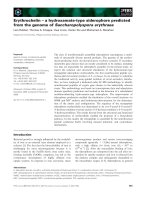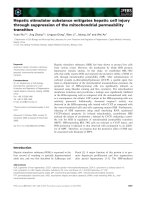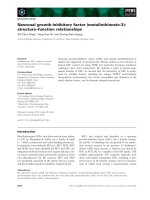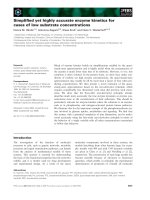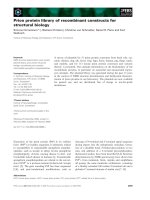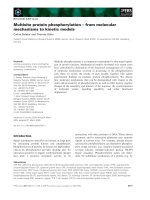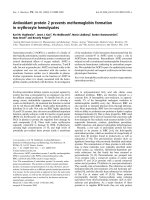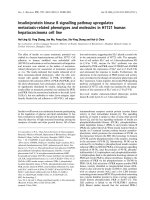Báo cáo khoa học: Calcium-dependent protein–protein interactions induce changes in proximity relationships of Cys48 and Cys64 in chicken skeletal troponin I ppt
Bạn đang xem bản rút gọn của tài liệu. Xem và tải ngay bản đầy đủ của tài liệu tại đây (382.94 KB, 9 trang )
Calcium-dependent protein–protein interactions induce changes
in proximity relationships of Cys48 and Cys64 in chicken
skeletal troponin I
Ying-Ming Liou and Ming-Wei Chen
Department of Life Science, Institute of Biochemistry, National Chung-Hsing University, Taichung, Taiwan
The goal of this study was to relate conformational changes
in the N-terminal domain of chicken troponin I (TnI) to
Ca
2+
activation of the actin–myosin interaction. The two
cysteine residues in this region (Cys48 and Cys64) were
labeled with two sulfhydryl-reactive pyrene-containing
fluorophores [N-(1-pyrene)maleimide, and N-(1-pyrene)-
iodoacetamide]. The labeled TnI showed a typical fluores-
cence spectrum: two sharp peaks of monomer fluorescence
and a broad peak of excimer fluorescence arising from the
formation of an excited dimer (excimer). Results obtained
show that forming a binary complex of labeled TnI with
skeletal TnC (sTnC) in the absence of Ca
2+
decreases the
excimer fluorescence, indicating a separation of the two
residues. This reduction in excimer fluorescence does not
occur when labeled TnI is complexed with cardiac TnC
(cTnC). The latter causes only partial activation of the
Ca
2+
-dependent myofibrillar ATPase. The binding of Ca
2+
to the two N-terminal sites of sTnC causes a significant de-
crease in excimer fluorescence and an increase in monomer
fluorescence in complexes of labeled TnI with skeletal TnC
or TnC/TnT, while Ca
2+
binding to site II of cTnC only
causes an increase in monomer fluorescence but no change in
excimer fluorescence. Thus a conformational change in the
N-terminal region of TnI may be necessary for full activation
of muscle contraction.
Keywords: proximity relationships; cysteine residues;
pyrene-containing fluorophores; monomer fluorescence;
excimer fluorescence.
Ca
2+
activation of striated muscle is mediated by the
troponin complex. Troponin is composed of three subunits:
troponin C (TnC), a Ca
2+
binding subunit; troponin I
(TnI), an inhibitory subunit and troponin T (TnT), a
subunit which binds the complex to tropomyosin. Based on
several experimental approaches, such as crystallography
[1–3], NMR [4–6], neutron scattering [7,8], chemical cross-
linking [9–11] and fluorescence resonance energy transfer
[12,13], a structural model of the TnC–TnI complex was
proposed in which TnI winds around TnC in either a left-
handed manner (Model ÔLÕ) or a right-handed manner
(Model ÔRÕ) [14]. According to these models, five adjoining
segments of TnI, segment I–V, correspond to residues 3–33,
34–53, 54–94, 95–114 and 115–134, respectively. Segment I
is an a-helix that binds to the C-terminal hydrophobic cleft
of TnC. Segment II does not posses a regular secondary
structure [3,7], and is postulated to act as a Ôflexible tetherÕ
between segment I and III. Segment III, also an a-helix, is
thought to interact with TnT [15,16]. Segment IV, corres-
ponding to the so-called inhibitory region of TnI [17],
adopts a b-hairpin structure and binds to the central helix of
TnC upon Ca
2+
activation. This fragment can fully inhibit
actin–myosin ATPase activity and bind alternatively to
actin and TnC during the contractile cycle [18]. Segment V,
containing an a-helical structure, binds to the hydrophobic
cleft of the N-terminal domain of TnC.
There are two cysteine residues (Cys48 and Cys64) in the
N-terminal end of TnI from both chicken and rabbit fast
skeletal muscle and a third cysteine (Cys133) in rabbit
TnI [19]. Cys48 is located at segment II, while Cys64 at
segment III. Compounds that contain the pyrene group,
such as N-(1-pyrene)-maleimide (PM) and N-(1-pyrenyl)-
iodoacetamide (PIA) were shown to be suitable for the
study of proximity relations between labeled cysteines
[20,21]. Strasburg et al. [22] first used PM to label the two
N-terminal cysteine residues of rabbit fast skeletal TnI. The
fluorescence spectrum of pyrene-labeled TnI exhibits peaks
characteristic of pyrene in its monomeric form as well as
an additional red-shifted peak due to the formation of an
excimer. This spectrum was compared to fluorescence
spectra obtained for the TnI–TnC complex, with and
without calcium. Conformational changes that occurred
during calcium binding to the TnI–TnC complex, were
monitored as a change in excimer fluorescence. Thus, the
calcium-induced structural changes that took place in the
TnI–TnC-binding region upon calcium binding might well
be transmitted to TnT as part of the events regulating
muscle contraction. However, the rabbit TnI has an
additional Cys133. In the experiments of Strasburg et al.
[22], this was blocked with iodoacetamide, thereby
Correspondence to Y M. Liou, Department of Life Science, National
Chung-Hsing University, 250 Kuokang Road, Taichung 402, Taiwan.
Fax: + 886 4 22851797, Tel.: + 886 4 22851802,
E-mail:
Abbreviations: TnI, troponin I; TM, tropomyosin; TnC,
troponin C; TnT, troponin T; PM, N-(1-pyrene)-maleimide;
PIA, N-(1-pyrenyl)-iodoacetamide; BCA, bicinchoninic acid.
(Received 11 March 2003, revised 18 May 2003,
accepted 2 June 2003)
Eur. J. Biochem. 270, 3092–3100 (2003) Ó FEBS 2003 doi:10.1046/j.1432-1033.2003.03700.x
introducing a possible confounding factor not present with
chicken TnI. In this study we have labeled the two N-
terminal cysteine residues of chicken pectoral muscle TnI
with either PM or PIA. We have used this preparation to
further characterize the Ca
2+
-induced proximity changes of
Cys48 and Cys64 in TnI during Ca
2+
binding to the ternary
complex of TnI–TnC–TnT.
In addition, the amino acid sequences of skeletal and
cardiac TnC and TnI are different [19,23–26], in particular,
at their binding interfaces. These differences might alter the
TnI–TnC interaction and thus affect muscle regulation.
Chicken fast skeletal TnC is a polypeptide of 159 amino acid
residues that contains four Ca
2+
binding sites [24,25].
The two C-terminal sites (III and IV) of TnC bind Ca
2+
with high affinity (K % 10
7
M
)1
)andalsoMg
2+
(K % 10
3
M
)1
). Occupation of these sites facilitates the
binding of TnC to the thin filament. The other two
N-terminal sites (I and II) bind Ca
2+
exclusively but
with lower affinity (K % 10
5
M
)1
). Binding of Ca
2+
to the
N-terminal sites is responsible for activation of actomyosin
ATPase activity. Due to some amino acid substitutions at
Ca
2+
binding loop I [23], porcine cardiac TnC binds 3 mol
Ca
2+
per mol protein [26]. In this study, we also compared
the effects of sTnC and cTnC to test if an isoform-specific
interaction of TnI and TnC is required for the Ca
2+
-
induced proximity change in the two N-terminal cysteines
of TnI.
Materials and methods
Reagents
Unless otherwise specified, all reagents used were ACS
grade. N-(1-pyrene)maleimide (PM) and N-(1-pyrene)iodo-
acetamide (PIA) were purchased from Molecular Probes.
Chromatographic reagents (DEAE-sephadex A-50 and
CM-sephadex C-50) were purchased from Amersham
Pharmacia Biotech Asia Pacific. Bicinchoninic acid (BCA)
protein assay reagent was from Pierce Chemicals.
Protein preparation and modification
Troponin subunits were isolated from an ether powder
prepared from chicken pectoral muscle according to the
method of Potter [27]. CTnC was prepared from the left
ventricle of porcine hearts according to Szynkiewicz et al.
[28]. Purified proteins were stored freeze-dried in a freezer
()80 °C).
Before use, the freeze-dried TnI was dissolved in a
solution containing 8
M
urea, 3 m
M
dithiothreitol, 100 m
M
Mops (pH 7.0), 2 m
M
EDTA and 100 m
M
KCl to reduce
the two thiol groups at room temperature for 4 h. Follow-
ing exhaustive dialysis at 4 °C, the reduced TnI was reacted
at room temperature for 4 h with a two- to threefold molar
excess of PM, or PIA, following the method of Liou and
Fuchs [29]. The reaction was terminated with excess
dithiothreitol. The latter was removed by solvent exchange
with Centricon 10 ultrafiltration cells (Amicon). The pro-
teins were then dialyzed against 6
M
urea, 25 m
M
Mops
(pH 7.0) and 0.25
M
KCl at 4 °C. The dialysis against the
same buffer without urea was repeated twice. For the PM-
labeled TnI, it was further treated with 8
M
urea in alkaline
solution (25 m
M
Tris, pH 8.8) for 24 h at room temperature
to cleave the succinimido ring [20]. The protein was then
dialyzed against 10 m
M
Mops, pH 7.0 and 0.25
M
KCl. The
amount of bound pyrene was determined on the basis of
extinction coefficients of 23 000
M
)1
Æcm
)1
(at 345 nm) and
28 000
M
)1
Æcm
)1
(at 344 nm) for PM-labeled [22] and PIA-
labeled TnI [21], respectively. Concentrations of labeled
proteins were measured with the BCA protein assay reagent
[29]. The labeling ratio of pyrene to TnI was 1.8–2.0 mol
fluorophore per mol protein.
Reconstitution of the binary or ternary troponin com-
plexes was performed by mixing equimolar amounts of
each subunit in denaturing solution containing 6
M
urea,
1
M
KCl, 50 m
M
Mops (pH 7.0), 5 m
M
CaCl
2
,and5m
M
dithiothreitol, followed by renaturation by dialysis to
remove urea and to lower the salt concentration. The
reconstituted protein complex in a buffer solution contain-
ing 10 m
M
Mops (pH 7.0), 1 m
M
MgCl
2
,1 m
M
EGTA, and
0.25
M
KCl was stored at )80 °Cbeforeuse.
ATPase activity assay
The biological activities of the labeled proteins were assayed
by determining Ca
2+
-activated myofibrillar ATPase acti-
vity. Chicken skeletal myofibrils were prepared at 4 °C
according to Liou et al. [30]. The endogenous TnC and TnI
were extracted by incubating the myofibrils with purified
TnT (myofibril: TnT ¼ 2 : 1, w/w) in a solution containing
100 m
M
Mops (pH 7.0), 90 m
M
KCl, 5 m
M
MgCl
2
,2m
M
EGTA and 1 m
M
dithiothreitol, at room temperature for
1 h, as described by Shiraishi et al.[31].Thedegreeof
extraction was compared by gel electrophoresis and by the
loss of Ca
2+
-activated ATPase activity, as described
previously [30].
Unlabeled or pyrene-labeled TnI, in complex with TnC,
were mixed with the TnT-treated myofibrils in a ratio of
0.25 mg TnI or TnC per milligram myofibrillar protein. The
myofibrils were suspended in 100 m
M
Mops (pH 7.0),
90 m
M
KCl, 5 m
M
MgCl
2
and 2 m
M
EGTA. After
incubation at room temperature for 1 h, the myofibrils
were centrifuged at 2600 g to remove free TnI or TnC. The
pellet was suspended in the same buffer solution.
The actomyosin ATPase activity was measured by
suspending the intact, extracted and reconstituted myofibrils
(0.4 mgÆmL
)1
)in100m
M
Mops (pH 7.0), 90 m
M
KCl,
5m
M
MgCl
2
,2m
M
EGTA and various additions as
indicated. The reaction mixtures were shaken in a water
bath at controlled temperature (30 °C) for 10 min. The
reaction was initiated by the addition of MgATP to a
concentration of 1 m
M
and terminated after 10 min by the
addition of malachite green reagent (33% malachite green,
16.7% polyvinyl alcohol, and 16.7% ammonium molyb-
date). The mixture was then analysed for inorganic phos-
phate release [30].
Fluorescence measurements
Pyrene-labeled TnI (1–2 l
M
), either alone or complexed
with other troponin subunits, was dissolved in 100 m
M
Mops (pH 7.0), 0.25 m
M
KCl and 2 m
M
EGTA, with
additions as indicated. Corrected fluorescence spectra were
recorded with a Perkin-Elmer LS 50 B spectrofluorimeter
Ó FEBS 2003 Conformational changes in chicken sTnI (Eur. J. Biochem. 270) 3093
(Beaconsfield, Buckinghamshire, England) at a constant
temperature of 25 °C. The solution was excited at 345 nm
and the fluorescence emission was scanned from 370–
570 nm, with slit widths of 3 and 10 nm for excitation and
emission, respectively.
Ca
2+
titration
Pyrene-labeled protein solutions were placed in a semimicro
cell (1 mL) and Ca
2+
titrations were carried out using a
digital micropipette using aliquots of a commercial standard
solution (Radiometer) of 0.1
M
CaCl
2
. Total volume change
with Ca
2+
addition did not exceed 2%. The emitted
fluorescence at 385 and 485 nm and the relative ratio of
fluorescence emitted at 485 nm to that at 385 nm were
taken for data analysis on the Ca
2+
dependent fluorescence
changes in pyrene-labeled TnI in I–C complex or in a whole
Tn complex. The measured fluorescence at the actual
pCa (–log[Ca
2+
]) was subtracted from that at pCa 8. The
subtracted fluorescence (F
x
) was normalized to the value
(F
0
) at saturating pCa. If normalized fluorescence (U ¼
F
x
/F
0
) is used, then a straight line is obtained with the
expression of log[U/(1–U)] vs. the logarithm of the Ca
2+
concentration. This plot was fitted using the Hill equation:
log½U=ð1 À UÞ ¼ nðlog½Ca
x
Þ þ log k
where, [Ca
x
]istheactualCa
2+
concentration, n (Hill
coefficient) is the slope, and k is the x-axis intercept of the
fitted line. The Hill coefficient is a measure of cooperativity
for the Ca
2+
-induced fluorescence changes in pyrene-
labeled TnI complexed with TnC or TnC/TnT. By using
the constants derived from the Hill equation, the curves of
the normalized fluorescence changes (F
x
/F
0
)vs.pCawere
fitted by computer with the equation:
ðF
x
=F
0
Þ¼½Ca
x
n
=fðEC
50
Þ
n
þ½Ca
x
n
g
where EC
50
is the Ca
2+
concentration giving 50% activa-
tion of fluorescence changes.
Free Ca
2+
concentrations in EGTA buffers were calcu-
lated on the basis of constants tabulated by Fabiato and
Fabiato [32]. The pCa values were calculated by the
computer program
EQCAL
(Biosoft, Cambridge, UK).
Statistics
Quantitative values are expressed as mean ± SEM. Com-
parisons of statistics were performed by a Student’s t-test
where P-values less than 0.05 were considered as being
significant [33].
Results
Biological activity of pyrene-labeled TnI
In interpreting the experimental results it is important to
know whether the modified protein retains biological
activity. In this case, biological activity is expressed in terms
of the ability of the modified TnI to modulate Ca
2+
regulation of myofibrillar ATPase activity. Following
extraction of TnC and TnI from skeletal myofibrils, by
adding exogenous TnT to replace the endogenous Tn in
skeletal myofibrils, either TnC with the native and modified
TnI were inserted into the myofibrils as described in Method
section. The results are shown in Table 1. The ATPase
activity of unextracted myofibrils in the absence of Ca
2+
was 21% of that in the presence of Ca
2+
. As expected, the
myofibrillar ATPase activity showed no Ca
2+
dependence
following extraction of TnC and TnI. Reinsertion of the
modified TnI (PM–TnI and PIA–TnI) into extracted
myofibrils restored Ca
2+
-activated ATPase activity as
effectively as native TnI, as shown in Table 1.
Pyrene-labeled TnI in complex with TnT and TnC
When pyrene-labeled TnI formed a binary complex with
TnT or TnC, the ratio of excimer fluorescence to monomer
fluorescence (E/M ratio) was significantly reduced. A
reduction (% 5%) was observed when TnT was complexed
with either the PM-labeled or PIA-labeled TnI. As shown in
Fig. 1A,C, and Fig. 2, this reduction for the complex of
pyrene-labeled TnI with TnT results from significant
increases in monomer fluorescence (5–10%) but no appar-
ent changes in excimer fluorescence. This result suggests that
TnT binding to TnI affects the local environment of the two
labeled cysteine residues but does not cause significant
changes in distance between these two sites. In contrast,
greater reductions in the E/M ratio were observed when
TnC was complexed with PIA–TnC (% 20%) and PM–TnI
(% 15%) as the results of an increase in monomer fluores-
cence (5–10%) and a decrease in excimer fluorescence
(10–15%) (Figs 1B,D and 2). This finding suggests that the
Cys48–64 distance is increased in the TnI–TnC complex.
The formation of a ternary complex with TnT and TnC was
also associated with an increase in monomer fluorescence
and a decrease in excimer fluorescence (Figs 1 and 2). These
data suggest that TnI contains different interaction sites for
TnC and TnT and that interactions among these subunits
can cause conformational changes in the N-terminal
domain of TnI.
Metal binding
When the pyrene-labeled TnI formed a binary complex with
TnC or a ternary complex with TnC and TnT, addition
of 5 m
M
Mg
2+
did not cause significant changes in the
fluorescence emission spectrum (Fig. 3A), whereas, addition
of Ca
2+
(pCa 4) elicited an increase in monomer fluores-
cence (5–10%) and a decrease in excimer fluorescence
(10–45%) (Fig. 3B,C,D). Results obtained with Ca
2+
titration to pyrene-labeled TnI in binary complex with
TnC or ternary complex with TnC and TnT are shown in
Fig. 4. It appears that the binding of Ca
2+
to the two low
affinity sites of TnC in a binary complex (pK
Ca
% 6.61) or in
a ternary complex (pK
Ca
% 6.59) would account for the
proximity changes of the two cysteines in TnI.
Ca
2+
effect on pyrene-labeled TnI complex with cardiac
troponin C
Morimoto & Ohtsuki [34] and Putkey et al. [35] have shown
that cTnC, when substituted into fast skeletal myofibrils,
was only partially effective in activating Ca
2+
-dependent
ATPase activity. In agreement with these reports, the
3094 Y M. Liou and M W. Chen (Eur. J. Biochem. 270) Ó FEBS 2003
present study shows that reinsertion of cardiac TnC with
modified TnI (PIA–TnI) into extracted myofibrils only
partially restored Ca
2+
-activated ATPase activity (Table 1).
The degree of reinsertion of pyrene-labeled TnI in complex
with both sTnC and cTnC into TnT-treated myofibrils was
compared by running the SDS/PAGE. Densitometric
analyses (Fig. 5A) show that both sTnC and cTnC in
complex with labeled TnI have the same degree of
re-incorporation (% 90%) into TnT-treated skeletal myo-
fibrils. Experiments were then carried out to determine if
the binding of cTnC to TnI altered the proximity between
Cys48–64 of TnI. In contrast to the results obtained with
the PIA-TnI/sTnC complex (Figs 1B and 2A), the
Table 1. ATPase activities of control, TnT-treated and reconstituted myofibrils. Myofibrils (0.2–0.4 mgÆmL
)1
) were dissolved in 100 m
M
Mops
(pH 7.0) 90 m
M
KCl, 5 m
M
MgCl
2
,2m
M
EGTA and Ca
2+
concentration as indicated. The ATPase assay was described in Method section.
Values are expressed as nmol P
i
Æmg proteinÆmin
)1
. Each value is the mean ± SEM, with number of measurements (n), as indicated.
Myofibrils Measurements (n)
Calcium concentration
pCa 8 pCa 4
Control 9 63.29 ± 3.83 286.37 ± 22.0
TnT-Treated 9 107.46 ± 17.63 110.42 ± 15.7
TnT-Treated + TnI + TnC 6 66.43 ± 5.23 303.83 ± 11.32
TnT-Treated + PIA-TnI + TnC 6 64.8 ± 3.23 277.25 ± 14.01
TnT-Treated + PM-TnI + TnC 6 59.07 ± 2.22 301.18 ± 1.73
TnT-Treated + PIA-TnI + cTnC 3 54.72 ± 2.86 102.35 ± 12.53
Fig. 1. Effect of TnT (A, C) and TnC (B, D) on the fluorescence emis-
sion spectrum of PIA-labeled (A, B), and PM-labeled TnI (C, D). Pyrene
fluorescence emission spectra were recorded from solutions of 1 l
M
pyrene-labeled TnI, and 1 l
M
pyrene-labeled TnI in complex with
3 l
M
TnC or/and 3 l
M
TnT. Solution composition is 100 m
M
Mops
(pH 7.0), 0.25
M
KCl and 2 m
M
EGTA.
Fig. 2. Changes in monomer and excimer fluorescence of (A) PIA-
labeled and (B) PM-labeled TnI incorporated into the complexes with
TnT and TnC. Fluorescence changes were calculated by subtracting the
fluorescence of monomer (at 385 nm) and excimer for the binary or
ternary complex from each intensity for the labeled TnI alone, and
then normalizing the difference of each to the value for the labeled TnI
alone. Solution composition is as in Fig. 2. Each histogram shows
mean (± SEM) of five measurements.
Ó FEBS 2003 Conformational changes in chicken sTnI (Eur. J. Biochem. 270) 3095
formation of a binary complex of PIA-TnI with cTnC (in
the absence of Ca
2+
)causedanincrease(% 12%) in
monomer fluorescence but no change in excimer fluores-
cence (Fig. 5B,C). Upon the addition of Ca
2+
there was a
further increase (% 25%) in monomer fluorescence but no
significant change in excimer fluorescence (Fig. 5B,C,D).
The half maximal increase in monomer fluorescence
occurred at pCa % 6.11, as compared to % 6.34 for sTnC
complexed with PIA-labeled TnI (Fig. 4D). Thus, both with
and without Ca
2+
, sTnC and cTnC elicit different con-
formational changes in the N-terminal region of TnI.
Discussion
According to the model of the TnC–TnI complex proposed
by Tung et al. [14], the predicted Cys48–64 distances are
approximately 26.8 A
˚
and 21.3 A
˚
for the L and R models,
respectively. For PM- and PIA-labeled TnI, the estimated
pyrene-SH bond length is approximately 11.7 and 11.5 A
˚
,
respectively. Apparently, the two pyrene labels at Cys48
and 64 have no spatial constraints to the formation of the
excimer. When pyrene-labeled TnI forms a binary complex
with TnC in the absence of Ca
2+
, excimer fluorescence is
decreased and monomer fluorescence is increased (Figs 1
and 2). This reduction in excimer fluorescence indicates
separation between Cys48 and 64 caused by the formation
of a binary complex with TnC. This result is consistent with
the notion that the antiparallel arrangement of TnI and
TnC would lead to a more elongated configuration of the
troponin complex [36–38]. There are multiple interactions
between TnI and TnC, involving regions located in the
N-terminal hydrophobic cleft (residues 51–62), central helix
(residues 89–100), and the C-terminal hydrophobic cleft
(residues 127–138) of TnC and regions located in the
N-terminal part (residues 1–47) and the C-terminal part
(residues 96–117 and 118–129) of TnI [3,13,17,39,40].
However, Strasburg et al. [22] observed that formation of
a complex between pyrene-labeled TnI and TnC in the
absence of Ca
2+
had little effect on the spectrum. It is
possible that the reaction of iodoacetamide with Cys133
of rabbit TnI altered the TnI–TnC interaction in the
absence of Ca
2+
.
Addition of TnT to pyrene-labeled TnI caused a small
increase in monomer fluorescence but no apparent change
in excimer fluorescence (Figs 1 and 2). This small change in
fluorescence emission might be a consequence of the bulky
pyrene groups causing some interference with the binding of
TnT to TnI [22]. There is also evidence that TnI segment
53–106 that has properties of a heptad repeat, may bind
to a similar heptad repeat region on TnT segment 205–255
in a coiled–coil interaction [41,42].
It has been suggested that the N-terminal region next to
the inhibitory segment (96–116) of TnI does not play a
regulatory role in the activation of contraction. Rather, it
plays a structural role by anchoring the troponin complex to
the thin filament [38]. Studies with a TnI N-terminal
Fig. 3. Effect of divalent cation binding on fluorescence emission spectra of pyrene-labeled TnI in a binary complex with TnC or in a ternary complex
with TnC and TnT. (A) Effect of Mg
2+
on spectrum of PIA-labeled TnI–TnC–TnT. Solutions contained 1 l
M
PIA-labeled TnI, 3 l
M
TnC, 3 l
M
TnT, 100 m
M
Mops (pH 7.0), 0.25
M
KCl, 2 m
M
EGTA, with or without 5 m
M
Mg
2+
. (B) Effect of Ca
2+
on spectrum of PIA-labeled TnI–TnC.
Solutions contained 1 l
M
PIA-labeled TnI, 3 l
M
TnC, 100 m
M
Mops (pH 7.0), 0.25
M
KCl, 2 m
M
EGTA, with or without 2.1 m
M
Ca
2+
. (C) Effect
of Ca
2+
on spectrum of PIA-labeled TnI–TnC–TnT. Solutions contained 1 l
M
PIA-labeled TnI, 3 l
M
TnC, 3 l
M
TnT, 100 m
M
Mops (pH 7.0),
0.25
M
KCl, 2 m
M
EGTA, with or without 2.1 m
M
Ca
2+
. (D) Effect of Ca
2+
binding on monomer (at 385 nm), excimer (at 485 nm) fluorescence
peaks, and the ratio of excimer fluorescence to monomer fluorescence (E/M ratio) for PM-labeled TnI in a binary complex with TnC or in a ternary
complex with TnC and TnT. Solutions contained 1 l
M
PM-labeled TnI, 3 l
M
TnC or 3 l
M
TnT, 100 m
M
Mops (pH 7.0), 0.25
M
KCl, 2 m
M
EGTA, with or without 2.1 m
M
Ca
2+
.
3096 Y M. Liou and M W. Chen (Eur. J. Biochem. 270) Ó FEBS 2003
deletion mutant (TnI
58)182
) showed that absence of the
N-terminal residues 1–57 caused a modified interaction with
TnT and loss of the ability to form a ternary complex
with TnT and TnC [43]. However, when TnI
58)182
was
incorporated into the troponin complex there was a Ca
2+
-
dependence of actomyosin ATPase activity that was essen-
tiallythesameasthatseeninthepresenceofintactTnI[44].
As shown in this study, the binding of Ca
2+
to the
regulatory sites of TnC clearly affects the relative proximity
between the two cysteine residues in the N-terminal region
of TnI, both in the TnC–TnI and TnC–TnI–TnT complexes
(Fig. 4). The same conclusion was also drawn in earlier
work with rabbit muscle proteins [22]. This conformational
change in the N-terminal region of TnI may be attributed to
the Ca
2+
-induced flexibility increase in either TnI–TnC
complex [45] or in a whole troponin complex [46]. Although
evidence has been presented that the N-terminus of TnI
interacts with the C-terminal end of TnT in a Ca
2+
-
independent manner [11,36], the Ca
2+
-induced proximity
changes that occur in the N-terminal region of TnI may also
contribute to the Ca
2+
-activation of muscle contraction.
Studies with recombinant TnT and TnI fragments by
Malnic et al. [47] showed that the N-terminal region of TnI
together with TnC was stabilized in the troponin complex
through a Ca
2+
-independent interaction with the C-termi-
nus of TnT. Their studies also indicated that this interaction
is essential for full Ca
2+
-activation by the ternary complex.
Recently, Rarick et al. [48] have addressed the same
question with respect to the importance of the N-terminus
of cardiac TnI in the activation and regulation of cardiac
myofilaments. They prepared a wild-type mouse cardiac
TnI, and two N-terminal deletion mutants: cTnI
54)211
(deleting the binding site for the C-terminal hydrophobic
cleft of cTnC), cTnI
80)211
(deleting the binding site for the
cTnT). Their data provided evidence in support of a
significant function of a cTnT-binding domain in cTnI, and
they suggested that cTnT binding to the N-terminus of cTnI
is a negative regulator of cardiac activation. More recently,
Ngai et al. have characterized a minimum sequence of the
N-terminus of TnI (residues 1–30) that retains full biological
activity to bind the C-terminal domain of TnC [49], and
showed that the N- and C-terminal domains of TnI act as a
Ca
2+
-dependent switch for TnC [50]. Thus, the N-terminal
region of TnI may participate in the calcium activation of
muscle contraction in cardiac and skeletal muscle.
Earlier work by Morimoto and Ohtsuki [34] examined
the effect of cTnC on the pCa-ATPase activity in CDTA-
replaced skeletal myofibrils. Their results showed that cTnC
is only partially effective in restoring ATPase activity to the
CDTA-treated skeletal myofibrils. Using recombinant
cTnC (wild type) and mutants (Site II inactive, Site I active,
and Site I active but Site II inactive), Putkey et al. [35]
found that substitution with all of these cTnCs can only
partially restore the calcium-dependent myofibrillar ATPase
Fig. 4. Ca
2+
+
-dependent fluorescence changes of pyrene-labeled TnI in the binary complex with TnC or in the ternary complex. (A) PM-labeled TnI–
TnC complex and (B) PM-labeled TnI–TnC–TnT complex show normalized monomer and excimer fluorescence as a function of pCa. Relative
fluorescence of monomer (at 385 nm) and excimer (at 485 nm) at each pCa was obtained by subtracting the fluorescence measured at each pCa
from that at pCa 8, and then normalizing the value to the difference at pCa 4. The curve was fitted to the data using the Hill equation as described in
Materials and methods. Hill coefficients (n) and the pCa values for giving 50% fluorescence change (pK
Ca
) are indicated. Solutions contained 1 l
M
PM-labeled TnI, 3 l
M
TnC, or 3 l
M
TnT, in 100 m
M
Mops (pH 7.0), 0.25
M
KCl, 2 m
M
EGTA, 5 m
M
Mg
2+
, and varying pCa. (C) Pyrene
fluorescence of PM-labeled TnI–TnC and PM-labeled TnI–TnC–TnT vs. pCa. 1 l
M
PM-labeled TnI formed a binary complex with 3 l
M
TnC or a
ternary complex with 3 l
M
TnC and TnT in 100 m
M
Mops buffer. Pyrene fluorescence was expressed as the ratio of monomer (at 385 nm) to
excimer (at 485 nm) fluorescence peaks. (D) Ca
2+
titration on monomer (at 385 nm), excimer (at 485 nm) fluorescence peaks, and the ratio of
excimer fluorescence to monomer fluorescence (E/M ratio) for PIA-labeled TnI–TnC. 1 l
M
PIA-labeled TnI formed a binary complex with 3 l
M
TnC in100 m
M
Mops (pH 7.0), 0.25
M
KCl, 2 m
M
EGTA, 5 m
M
Mg
2+
, and varying pCa. Each point is mean ± SEM of five measurements.
Ó FEBS 2003 Conformational changes in chicken sTnI (Eur. J. Biochem. 270) 3097
activity for sTnC-extracted skeletal myofibrils. In this study,
when cTnC was substituted for sTnC, no excimer fluores-
cence was found in the complex with pyrene-labeled TnI
(Fig. 5). The binding of Ca
2+
to cTnC (pK
Ca
¼ 6.11) only
caused the monomer fluorescence to increase but had no
changes in excimer (Fig. 5C,D). The inability of cTnC to
efffect a change in Cys48–64 distance suggests that a
conformational change in the N-terminal region of TnI is
essential for full activation of skeletal muscle contraction.
We are currently carrying out more experiments with TnI
fragments and segment-deletion TnI mutants to test if the
TnI C-terminal end is required to mediate this Ca
2+
-
induced structural change in the N-terminal domain of TnI.
Future studies will also relate such changes to the functional
roles of TnI in skeletal muscle contraction.
References
1.Houdusse,A.,Love,M.L.,Dominguez,R.,Grabarek,Z.&
Cohen, C. (1997) Structures of four Ca
2+
-bound troponin C at
2.0 A
˚
resolution: further insights into the Ca
2+
-switch in the cal-
modulin superfamily. Structure 5, 1695–1711.
2. Strynadka, N.C.J., Cherney, M., Sielecki, A.R., Li, M.X., Smillie,
L.B. & James, M.N.G. (1997) Structural details of a calcium-
induced molecular switch: X-ray crystallographic analysis of the
calcium-saturated N-terminal domain of troponin C at 1.75 A
˚
resolution. J. Mol. Biol. 273, 238–255.
3. Vassylyev, D.G., Takeda, S., Wakatsuki, S., Maeda, K. & Maeda,
Y. (1998) Crystal structure of troponin C in complex with tro-
ponin I fragment at 2.3-A
˚
resolution. Proc. Natl Acad. Sci. USA
95, 4847–4852.
4. McKay, R.T., Tripet, B.P., Hodges, R.S. & Sykes, B.D. (1997)
Interaction of the second binding region of troponin I with the
regulatory domain of skeletal muscle troponin C as determined by
NMR spectroscopy. J. Biol. Chem. 272, 28494.
5.McKay,R.T.,Pearlstone,J.R.,Corson,D.C.,Gagne,S.M.,
Smillie, L.B. & Sykes, B.D. (1998) Structure and interaction site of
the regulatory domain of troponin-C when complexed with the
96–148 region of troponin-I. Biochemistry 37, 12419–12430.
6. Mercier, P., Li, M.X. & Sykes, B.D. (2000) Role of the structural
domain of troponin C in muscle regulation: NMR studies of Ca
2+
binding and subsequent interactions with regions 1–40 and 96–115
of troponin I. Biochemistry 39, 2902–2911.
7. Olah, G.A. & Trewhella, J. (1994) A model structure of the muscle
protein complex 4Ca
2+
ÆTroponin CÆTroponin I derived from
small-angle scattering data: Implications for regulation. Bio-
chemistry 33, 12800–12806.
8. Stone, D.B., Timmins, P.A., Schneider, D.K., Krylova, I., Ramos,
C.H.I.,Reinach,F.C.&Mendelson,R.A.(1998)Theeffectof
regulatory Ca
2+
on the in situ structures of troponin C and
troponin I: a neutron scattering study. J. Mol. Biol. 281, 689–704.
9. Kobayashi, T., Tao, T., Grabarek, Z., Gergely, J. & Collins, J.H.
(1991) Cross-linking of residue 57 in the regulatory domain of a
mutant rabbit skeletal troponin C to the inhibitory region of
troponin I. J. Biol. Chem. 266, 13746–13751.
10. Luo,Y.,Leszyk,J.,Li,B.,Gergely,J.&Tao,T.(2000)Proximity
relationships between residue 6 of troponin I and residues in tro-
ponin C: Further evidence for extended conformation of troponin
C in the troponin complex. Biochemistry 39, 15306–15315.
11. Luo,Y.,Wu,J.L.,Li,B.,Langsetmo,K.,Gergely,J.&Tao,T.
(2000) Photocrosslinking of benzophenone-labeled single cysteine
troponin I mutants to other thin filament proteins. J. Mol. Biol.
296, 899–910.
Fig. 5. Effect of Ca
2+
+
on pyrene fluorescence of PIA-labeled TnI in a complex with cardiac troponin C. (A) Quantitative analysis of reinsertion of
PIA-labeled TnI in complex with sTnC and cTnC into TnT-treated skeletal myofibrils. SDS/PAGE and densitometic analysis were as described
previously [30]. Myofibril-bound TnI, TnT, sTnC and cTnC were estimated by normalizing the ratio of the area under the peaks of TnI, or TnT, or
sTnC or cTnC to that under the LC1 (myosin light chain 1) peak. Each column is shown as the mean ± SEM of three different gel scans.
(B) Fluorescence emission spectra of PIA–TnI and PIA–TnI/cTnC at pCa 8 and pCa 4. (C) Effects of cTnC and Ca
2+
on monomer (at 385 nm),
excimer (at 485 nm) fluorescence peaks, and the ratio of excimer fluorescence to monomer fluorescence (E/M ratio) for PIA-labeled TnI.
(D) Relative excimer and monomer fluorescence of PIA-labeled TnI-cTnC as a function of pCa. PM-labeled TnI (1 l
M
) formed a binary complex
with cTnC (3 l
M
) from porcine heart in 100 m
M
Mops (pH 7.0), 0.1
M
KCl, 2 m
M
EGTA, 5 m
M
Mg
2+
and varying pCa. Each value is mean ±
SEM of five measurements.
3098 Y M. Liou and M W. Chen (Eur. J. Biochem. 270) Ó FEBS 2003
12. Luo,Y.,Wu,J.L.,Gergely,J.&Tao,T.(1997)TroponinTand
Ca
2+
dependence of the distance between Cys48 and Cys133 of
troponin I in the ternary troponin complex and reconstituted thin
filaments. Biochemistry 36, 11027–11035.
13. Luo,Y.,Wu,J.L.,Gergely,J.&Tao,T.(1998)Localizationof
Cys133 of rabbit skeletal troponin-I with respect to troponin-C
by resonance energy transfer. Biophys. J. 74, 3111–3119.
14. Tung, S.C., Wall, M.E., Gallagher, S.C. & Trewhella, J. (2000) A
model of troponin-I in complex with troponin-C using hybrid
experimental data: The inhibitory region is a b-hairpin. Protein.
Sci. 9, 1312–1326.
15. Chong, P.C. & Hodges, R.S. (1982) Proximity of sulfhydryl
groups to the sites of interaction between components of the
troponin complex from rabbit skeletal muscle. J. Biol. Chem. 257,
2549–2555.
16. Hitchcock, S.E., Zimmerman, C.J. & Smakkey, C. (1981) Study of
the structure of troponin-T by measuring the relative reactivities of
lysines with acetic anhydride. J. Mol. Biol. 147, 125–151.
17. Syska, H., Wilkinson, J.M., Grand, R.J. & Perry, S.V. (1976) The
relationship between biological activity and primary structure of
troponin I from white skeletal muscle of the rabbit. J. Biochem.
(Tokyo) 153, 375–387.
18. Van Eyk, J.E. & Hodges, R.S. (1988) The biological importance of
each amino acid residue of the troponin I inhibitory sequence
104–115 in the interaction with troponin C and tropomyosin-
actin. J. Biol. Chem. 263, 1726–1732.
19. Wilkinson, J.M. & Grand, R.J.A. (1978) Comparison of amino
acid sequence of troponin I from different striated muscles. Nature
271, 31–35.
20. Betcher-Lange, S.L. & Lehrer, S.S. (1978) Pyrene excimer fluor-
escence in rabbit skeletal aatropomyosin labeled with N-(1-py-
rene) maleimide. J. Biol. Chem. 253, 3757–3760.
21. Ishii, Y. & Lehrer, S.S. (1990) Excimer fluorescence of pyr-
enyliodoacetamide-labeled tropomyosin: a probe of the state of
tropomyosin in reconstituted muscle thin filaments. Biochemistry
29, 1160–1166.
22. Strasburg, G.M., Leavis, P.C. & Gergely, J. (1985) Troponin-C-
mediated calcium-sensitive changes in the conformation of
troponin I detected by pyrene excimer fluorescence. J. Biol. Chem.
260, 366–370.
23. Van Eerd, J.P. & Takahashi, K. (1975) The amino acid sequence
of bovine cardiac troponin-C: comparison with rabbit skeletal
troponin-C. Biochem. Biophys. Res. Commun. 64, 122–127.
24. Wilkinson, J.M. (1976) The amino acid sequence of troponin C
from chicken skeletal muscle. FEBS Lett. 70, 254–256.
25. Reinach, F.C. & Karlsson, R. (1988) Cloning expression, and site-
directed mutagenesis of chicken skeletal muscle troponin C. J. Biol.
Chem. 263, 2371–2376.
26. Kobayashi, T., Tagagi, T., Konishi, K., Morimoto, S. & Ohtsuki,
I. (1989) Amino acid sequence of porcine cardiac muscle troponin
C. J. Biochem. (Tokyo) 106, 55–59.
27. Potter, J.D. (1982) Preparation of troponin and its subunits.
Methods Enzymol. 85, 241–263.
28. Szynkiewicz, J., Stepkowski, D., Brzeska, H. & Drabikowski, W.
(1985) Cardiac troponin-C: a rapid and effective method of puri-
fication. FEBS Lett. 181, 281–285.
29. Liou, Y.M. & Fuchs, F. (1992) Pyrene-labeled cardiac troponin C:
Effects of Ca
2+
on monomer and excimer fluorescence in solution
and myofibrils. Biophys. J. 61, 892–901.
30. Liou, Y.M., Jiang, M.J. & Wu, M.C. (2002) Changes in thiol
reactivity and extractability of myofibril bound cardiac troponin C
in porcine malignant hyperthermia. J. Biochem. (Tokyo) 132,
317–325.
31. Shiraishi, F., Kambara, M. & Ohtsuki, I. (1992) Replacement of
troponin components in myofibrils. J. Biochem. (Tokyo) 111,
61–65.
32. Fabiato, A. & Fabiato. F. (1979) Calculator programs for com-
puting the composition of the multiple metals and ligands used
for experiments in skinned muscle cells. J. Physiol. (Paris) 75,
463–505.
33. Steel, R.G.D. & Torrie, J.H. (1980) Principles and Procedures of
Statistics: A Biometrical Approach, pp. 39–121. McGraw-Hill,
New York.
34. Morimoto, S. & Ohtsuki, I. (1987) Ca
2+
- and Sr
2+
-sensitivity of
the ATPase activity of rabbit skeletal myofibrils: Effect of the
complete substitution of troponin C with cardiac troponin C,
calmodulin, and parvalbumins. J. Biochem. (Tokyo) 101,
291–301.
35. Putkey,J.A.,Liu,W.&Sweeney,H.L.(1991)Functionofthe
N-terminal calcium-binding sites in cardiac/slow troponin C
assessed in fast skeletal muscle fibers. J. Biol. Chem. 266,
14881–14884.
36. Farah, C.S., Miyamoto, C.A., Ramos, C.H.I., da Silva, C.R.,
Quaggio, R.B., Fujimori, K., Smillie, L.B. & Reinach, F.C. (1994)
Structural and regulatory functions of the NH
2
-andCOOH-
terminal regions of skeletal muscle troponin I. J. Biol. Chem. 269,
5230–5240.
37. Tripet, B., Van Eyk, J.E. & Hodges, R.S. (1997) Mapping of a
second actin-tropomyosin and a second troponin C binding site
within the C terminus of troponin I, and their importance in the
Ca
2+
-dependent regulation of muscle contraction. J. Mol. Biol.
271, 728–750.
38. Perry, S.V. (1999) Troponin I: Inhibitor or facilitator. Mol. Cell
Biochem. 190, 9–32.
39.Leavis,P.C.,Rosenfeld,S.S.,Gergely,J.,Grabarek,Z.&
Drabikowski, W. (1978) Proteolytic fragments of troponin C:
Localization of high and low affinity Ca
2+
binding sites and
interactions with troponin I and troponin T. J. Biol. Chem. 253,
5452–5459.
40. Grabarek,Z.,Drabikowski,W.,Leavis,P.C.,Rosenfeld,S.S.&
Gergely, J. (1981) Proteolytic fragments of troponin C. Inter-
actions with the other troponin subunits and biological activity.
J. Biol. Chem. 256, 13121–13127.
41. Pearlstone, J.R. & Smillie, L.B. (1978) Troponin T fragments:
physical properties and binding to troponin C. Can. J. Biochem.
56, 521–527.
42. Stefancsik, R., Jha, P.K. & Sarkar, S. (1998) Identification and
mutagenesis of a highly conserved domain in troponin T
responsible for troponin I binding: Potential role for coiled coil
interaction. Proc. Natl Acad. Sci. USA 95, 957–962.
43. Sheng, Z., Pan, B.S., Miller, T.E. & Potter, J.D. (1992) Isolation,
expression, and mutation of a rabbit skeletal muscle cDNA clone
for troponin I. The role of the NH
2
terminus of fast skeletal muscle
troponin I in its biological activity. J. Biol. Chem. 267, 25407–
25413.
44. Potter, J.D., Sheng, Z., Pan, B.S. & Zhao, J. (1995) A direct reg-
ulatory role for troponin T and a dual role for troponin C in
the Ca
2+
regulation of muscle contraction. J. Biol. Chem. 270,
2557–2562.
45. Zhao, X., Kobayashi, T., Malak, H., Gryczynski, Z., Gryczynski,
I., Lakowicz, J., Wade, R. & Collins, J.H. (2000) Calcium-induced
flexibility changes in the troponin C-troponin I complex. Biochim.
Biophys. Acta 1494, 247–254.
46. Zhao, X., Kobayashi, T., Malak, H., Gryczynski, I.,
Lakowicz, J., Wade, R. & Collins, J.H. (1995) Calcium-
induced troponin flexibility revealed by distance distribution
measurements between engineered sites. J. Biol. Chem. 270,
15507–15514.
47. Malnic, B., Farah, C.S. & Reinach, F.C. (1998) Regulatory
properties of the NH
2
- and COOH-terminal domains of troponin
T. ATPase activation and binding to troponin I and troponin C.
J. Biol. Chem. 273, 10594–10601.
Ó FEBS 2003 Conformational changes in chicken sTnI (Eur. J. Biochem. 270) 3099
48. Rarick, H.M., Tang, H.P., Guo, X.D., Martin, A.F. & Solaro,
R.J. (1999) Interactions at the NH
2
-terminal interface of cardiac
troponin I modulate myofilament activation. J. Mol. Cell. Cardiol.
31, 363–375.
49. Ngai, S.M., Pearlstone, J.R., Smillie, L.B. & Hodges, R.S. (2001)
Characterization of the biologically important interaction between
troponin C and the N-terminal region of troponin I. J. Cell Bio-
chem. 83, 99–110.
50. Ngai, S.M., Pearlstone, J.R., Farah, C.S., Reinach, F.C.,
Smillie, L.B. & Hodges, R.S. (2001) Structural and functional
studiesontroponinIandtroponinCinteractions.J. Cell Biochem.
83, 33–46.
3100 Y M. Liou and M W. Chen (Eur. J. Biochem. 270) Ó FEBS 2003

